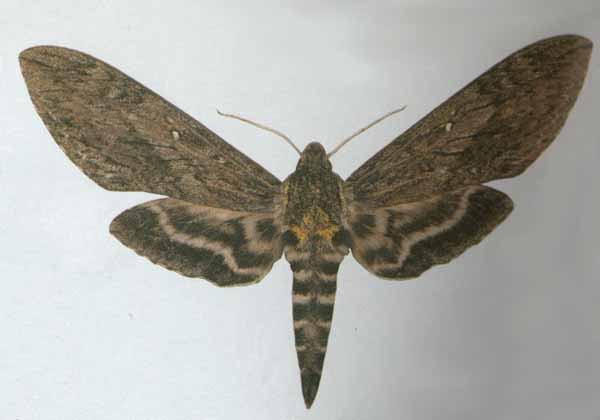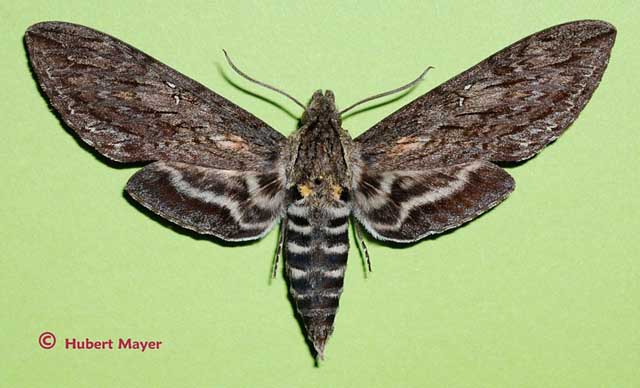Lintneria aurigutta
|
|
Updated as per
AN ANNOTATED CHECKLIST OF THE SPHINGIDAE OF BOLIVIA, October 2007
Updated as per More, Kitching and Cocucci's Hawkmoths of Argentina 2005, October, 2007
Updated as per personal communication with Fernando Penco, Argentina, May 2008; questionable in Argentina
Updated as per The Hawk Moths of the North America, 2007, James P. Tuttle (Sphinx to Lintneria); April 2009
Updated as per CATE; April 2009
Updated as per personal communication with Hubert Mayer (Oxapampa, La Suiza, Peru, July, 2100m); August 9, 2011
Updated as per personal communication with Ezequiel Bustos (Shilap revta. lepid. 43 (172) diciembre, 2015, 615-631 eISSN 2340-4078 ISSN 0300-5267), January 4, 2016
|
Lintneria aurigutta
(Rothschild & Jordan, 1903) Hyloicus

Sphinx aurigutta, Peru, courtesy of Vladimir Izersky.
This site has been created by
Bill Oehlke at oehlkew@islandtelecom.com
Comments, suggestions and/or additional information are welcomed by Bill.
TAXONOMY:
Family: Sphingidae, Latreille, 1802
Subfamily: Sphinginae, Latreille, 1802
Tribe: Sphingini, Latreille, 1802
Genus: Lintneria Butler, 1876 ...........
Species: aurigutta (Rothschild & Jordan, 1903)
|
MIDI MUSIC
.....It's a Wonderful World.....
copyright C. Odenkirk
ON.OFF
<bgsound src="world.mid" LOOP=FOREVER>
|
DISTRIBUTION:
Lintneria aurigutta
(Wing span: 52-58mm forewing length) flies in
Peru: (Pasco: Oxapampa: La Suiza, 2100m (HM)); Junin: La Merced
Bolivia: La Paz: southern Yungas (2020m, March; October),
Cochabamba (750m, November-December);
with very questionable reports noted by (EB) from Argentina???: Jujuy; Tucuman: Cochuna (FP).
I believe it has now been confirmed in JUjuy (2015; EB).
In his The Hawk Moths of North America, 2007, James P. Tuttle has assigned all the
Sphinx genus species from Mexico south throughout South American to Lintneria, Butler, 1876, based on
consistent differences in wing characters and significant larval differences.
"Similar to Lintneria lugens, but larger, less grey, the wings and body (apart from the abdomen) washed with
brown. Easily distinguished from Lintneria maura by the presence of black thoracic stripes, and much more distinctly marked
forewings.
"Metathorax upperside distinguished from Lintneria lugens by the presence of two golden-yellow spots. Abdomen upperside with
segments pale brown basally, dark distally, with a very faint mesial band.
"Palpus and sterna with a few grey scales.
"Forewing upperside with black markings not prominent (but more so than Lintneria maura) due to the dark background; an
indistinct russet patch present posterior to the discal cell proximal to the oblique antemedian double line; discal spot double,
prominent; apical oblique line narrow, broadly interrupted at vein Rs4; postmedian line running nearly straight from veins M2
to 1A+2A, interrupted at veins; submarginal line greyish white, irregular, generally parallel to wing margin.
"Hindwing upperside with bands less white than in Lintneria lugens, washed with brown as are the abdominal bands; basal black
patch not quite reaching base; antemedian grey band curved as in Lintneria merops; discal black band broadened from
veins M3 to [CuP], and including a grey patch at vein CuA2 and a smaller one at 1A." CATE

Lintneria aurigutta male, Oxapampa, La Suiza, Peru,
2100m, July 23, 2004, courtesy/copyright of Hubert Mayer.
FLIGHT TIMES:
Lintneria aurigutta adults have at
least three generations annually with
moths on the wing in March-April, July and again in December.
Hubert Mayer reports a July flight in Oxapampa, Peru.
Females are usually on the wing from 11:20pm until 2:00am while
males have slightly longer flight "span": 11:30pm until 2:30am.
Males come to lights much more readily than females.
ECLOSION:
Pupae probably wiggle to surface from
subterranean chambers just prior to eclosion.
SCENTING AND MATING:
Females call in the males with a
pheromone released from a gland at the tip of the
abdomen. Adults probably nectar at a variety of flowers.
EGGS, LARVAE, PUPAE:
Please visit my special request for images of Lintneria species larvae at
Lintneria larvae, and help if you can.
It is anticipated that the Lintneria larvae will most often be encountered on Lamiaceae: Salvia (Sage), Mentha (Mints), Monarda (Beebalm) and
Hyptis (Bushmints); Verbenaceae: Verbena and Lantana camara (shrub verbenas or lantanas).
Although they may be encountered feeding during daylight hours, one is even more likely to discover them feeding in the evening or after dark.
Two of the greatest clues for discovering larvae are stripped foliage and droppings beneath the plant. You might be quite surprised at what will turn up in the evening or
after dark in a flashlight assisted search.
It is believed that all "Lintneria larvae will exhibit "a fleshy thoracic dorsal "horn" in the first 4 instars (unique in the Sphingidae of the world to my
knowledge) which is replaced by a thoracic dorsal "hump" with a large black patch in the 5th instar." J.A. Tuttle.
Use your browser "Back" button to return to the previous page.
Return to Sphingidae Index
Return to Sphingini Tribe
Use your browser "Back" button to return to the previous page.
This page is brought to you by
Bill Oehlke and the
WLSS. Pages are on space rented from Bizland. If you would like
to become a "Patron of the Sphingidae Site", contact Bill.
Please send sightings/images to Bill. I will do my best to respond to
requests for identification help.
Enjoy one of nature's wonderments: Live
Saturniidae (Giant Silkmoth) cocoons.
 | 
Show appreciation for this site by clicking on flashing butterfly to the left.
The link will take you to a page with links to many insect sites. |



